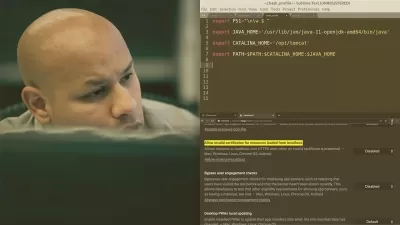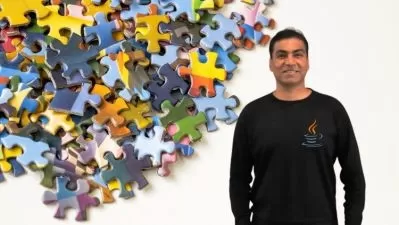Pearson - Java SE 11 Developer (1Z0-819)
Focused View
18:05:18
70 View
01-Java SE 11 Developer (1Z0-819) - Introduction.mp4
08:19
02-Module introduction.mp4
00:47
03-Learning objectives.mp4
00:43
04-1.1 Java operators - part 1.mp4
10:06
05-1.2 Java operators - part 2.mp4
10:48
06-1.3 Promotions.mp4
12:30
07-1.4 Casting.mp4
05:25
08-1.5 Wrapper classes.mp4
06:41
09-1.6 Question deep dive.mp4
06:27
10-Learning objectives.mp4
00:33
11-2.1 String and StringBuilder.mp4
06:25
12-2.2 Methods of the String class.mp4
07:05
13-2.3 Methods of the StringBuilder class.mp4
05:05
14-2.4 Question deep dive.mp4
04:10
15-Learning objectives.mp4
00:29
16-3.1 Using var for regular variables.mp4
03:31
17-3.2 Additional uses and restrictions of var.mp4
03:17
18-3.3 Question deep dive.mp4
03:02
19-Module introduction.mp4
00:40
20-Learning objectives.mp4
00:34
21-4.1 Simple loops.mp4
11:16
22-4.2 Control using break and continue.mp4
07:10
23-4.3 Using if else statements.mp4
03:22
24-4.4 Using switch statements.mp4
04:41
25-4.5 Question deep dive.mp4
06:56
26-Learning objectives.mp4
00:29
27-5.1 Flow control of try catch finally.mp4
18:32
28-5.2 Flow control of try-with-resources.mp4
04:00
29-5.3 Multi-catch and rethrowing.mp4
04:58
30-5.4 Question deep dive.mp4
05:58
31-Learning objectives.mp4
00:22
32-6.1 Subclassing Throwable types.mp4
03:15
33-6.2 Question deep Dive.mp4
03:11
34-Module introduction.mp4
01:21
35-Learning objectives.mp4
00:40
36-7.1 Source files and basic type declarations.mp4
06:32
37-7.2 Nested type declarations.mp4
08:31
38-7.3 Inner class declarations - part 1.mp4
07:06
39-7.4 Inner class declaration - part 2.mp4
15:22
40-7.5 Local and anonymous class declarations.mp4
09:45
41-7.6 Reachability analysis.mp4
12:59
42-7.7 Question deep dive.mp4
04:14
43-Learning objectives.mp4
00:47
44-8.1 Instance and static fields - part 1.mp4
08:52
45-8.2 Instance and static fields - part 2.mp4
12:09
46-8.3 Instance and static methods - part 1.mp4
08:57
47-8.4 Instance and static methods - part 2.mp4
11:09
48-8.5 Variable length argument handling.mp4
03:10
49-8.6 Overloaded and overridden methods - part 1.mp4
09:24
50-8.7 Overloaded and overridden methods - part 2.mp4
12:29
51-8.8 Question deep dive.mp4
03:34
52-Learning objectives.mp4
00:26
53-9.1 Static initialization.mp4
04:33
54-9.2 Instance initialization.mp4
12:13
55-9.3 Question deep dive.mp4
02:44
56-Learning objectives.mp4
00:39
57-10.1 Rules of scope.mp4
09:44
58-10.2 Access control modifiers.mp4
04:57
59-10.3 Encapsulation requirements.mp4
10:08
60-10.4 Immutability requirements.mp4
06:22
61-10.5 Question deep dive.mp4
04:39
62-Learning objectives.mp4
00:37
63-11.1 Subclass declaration.mp4
07:27
64-11.2 Subclass initialization.mp4
07:43
65-11.3 Abstract class constraints.mp4
01:36
66-11.4 Question deep dive.mp4
03:37
67-Learning objectives.mp4
00:53
68-12.1 Object and reference type.mp4
11:41
69-12.2 Possible and impossible casts.mp4
06:09
70-12.3 Virtual method invocation.mp4
06:01
71-12.4 Covariant returns.mp4
02:27
72-12.5 Question deep dive.mp4
02:54
73-Learning objectives.mp4
00:50
74-13.1 Interfaces, methods and functional interfaces.mp4
11:26
75-13.2 Interface implementation.mp4
04:29
76-13.3 Default method resolution.mp4
09:14
77-13.4 Question deep dive.mp4
02:49
78-Learning objectives.mp4
00:24
79-14.1 Enum values and initialization.mp4
06:02
80-14.2 Enum fields and methods.mp4
05:14
81-14.3 Question deep dive.mp4
03:04
82-Module introduction.mp4
00:33
83-Learning objectives.mp4
01:02
84-15.1 Reviewing fundamentals of generics.mp4
19:01
85-15.2 Declaring generic types and methods.mp4
09:50
86-15.3 Using bounds and wildcards.mp4
16:21
87-15.4 Question deep dive.mp4
04:56
88-Learning objectives.mp4
00:55
89-16.1 Arrays, and methods of Collection, List, and Set - part 1.mp4
16:22
90-16.2 Arrays, and methods of Collection, List, and Set - part 2.mp4
10:23
91-16.3 Methods of Deque and Map.mp4
14:46
92-16.4 Question deep dive.mp4
04:54
93-Learning objectives.mp4
00:37
94-17.1 Comparison methods and interfaces.mp4
04:45
95-17.2 Sorting arrays and Collections.mp4
02:38
96-17.3 Comparator factories and decorators.mp4
12:34
97-17.4 Question deep dive.mp4
02:29
98-Module introduction.mp4
00:39
99-Learning objectives.mp4
00:45
100-18.1 Lambda expression syntax variations.mp4
12:08
101-18.2 Lambda expression contexts.mp4
06:05
102-18.3 Core functional interfaces.mp4
10:35
103-18.4 Method references.mp4
12:16
104-18.5 Question deep dive.mp4
04:45
105-Learning objectives.mp4
00:44
106-19.1 The monad-like methods.mp4
08:41
107-19.2 Stream utilities.mp4
10:30
108-19.3 Simple terminal methods and laziness.mp4
10:09
109-19.4 Question deep dive.mp4
03:32
110-Learning objectives.mp4
00:58
111-20.1 Collection and reduction - part 1.mp4
13:08
112-20.2 Collection and reduction - part 2.mp4
06:42
113-20.3 Grouping and partitioning with Collectors.mp4
06:33
114-20.4 Downstream operations with Collectors.mp4
09:10
115-20.5 Parallel stream operation.mp4
07:21
116-20.6 Question deep dive.mp4
03:53
117-Module introduction.mp4
00:28
118-Learning objectives.mp4
00:39
119-21.1 Module compilation.mp4
17:33
120-21.2 Module execution.mp4
08:48
121-21.3 Question Deep Dive.mp4
02:05
122-Learning objectives.mp4
00:33
123-22.1 Exports and requires directives.mp4
13:10
124-22.2 Provides, uses, open and opens directives.mp4
16:08
125-22.3 Question Deep Dive.mp4
02:41
126-Module introduction.mp4
00:33
127-Learning objectives.mp4
00:51
128-23.1 Runnable and Thread.mp4
13:57
129-23.2 ExecutorService and Future.mp4
09:22
130-23.3 ExecutorService lifecycle - part 1.mp4
12:00
131-23.4 ExecutorService lifecycle - part 2.mp4
08:24
132-23.5 Question Deep Dive.mp4
04:33
133-Learning objectives.mp4
00:54
134-24.1 Race conditions, deadlock, and livelock.mp4
12:20
135-24.2 Transactional integrity.mp4
12:32
136-24.3 Visibility.mp4
16:49
137-24.4 Concurrent queues and collections.mp4
10:23
138-24.5 Synchronizers, locks, and atomic types - part 1.mp4
14:00
139-24.6 Synchronizers, locks, and atomic types - part 2.mp4
15:57
140-24.7 Question Deep Dive.mp4
01:26
141-Module introduction.mp4
00:48
142-Learning objectives.mp4
00:54
143-25.1 JDBC URLs, DriverManager, DataSource, and Connection.mp4
06:23
144-25.2 Statement and ResultSet.mp4
12:29
145-25.3 PreparedStatement.mp4
11:39
146-25.4 Question deep dive.mp4
02:43
147-Learning objectives.mp4
00:32
148-26.1 Input and Output streams, Reader and Writer.mp4
05:19
149-26.2 BufferedReader, PrintWriter, Scanner and Charset conversions.mp4
05:21
150-26.3 Question Deep Dive.mp4
01:17
151-Learning objectives.mp4
00:28
152-27.1 Default serialization.mp4
09:29
153-27.2 Customizing serialization.mp4
05:49
154-27.3 Question Deep Dive.mp4
05:05
155-Learning objectives.mp4
00:44
156-28.1 Files methods - part 1.mp4
08:47
157-28.2 Files methods - part 2.mp4
13:14
158-28.3 Working with Channels.mp4
07:36
159-28.4 Question Deep Dive.mp4
05:12
160-Module introduction.mp4
01:04
161-Learning objectives.mp4
00:36
162-29.1 Annotation declaration and elements.mp4
07:06
163-29.2 Target, retention, and inspection.mp4
08:49
164-29.3 Element types and repeatable annotations.mp4
03:06
165-29.4 Question deep dive.mp4
02:50
166-Learning objectives.mp4
00:29
167-30.1 Parsing, formatting, and locale.mp4
12:45
168-30.2 Resourcebundles and data lookup.mp4
11:37
169-30.3 Question Deep Dive.mp4
02:07
170-Learning objectives.mp4
00:21
171-31.1 Understanding key threats and mitigations.mp4
07:04
172-31.2 Question Deep Dive.mp4
03:47
173-Learning objectives.mp4
00:31
174-32.1 Understanding permissions and access control.mp4
10:12
175-32.2 Question Deep Dive.mp4
02:00
176-Java SE 11 Developer (1Z0-819) - Summary.mp4
01:29
More details
User Reviews
Rating
average 0
Focused display
Category

LiveLessons
View courses LiveLessonsPearson's video training library is an indispensable learning tool for today's competitive job market. Having essential technology training and certifications can open doors for career advancement and life enrichment. We take learning personally. We've published hundreds of up-to-date videos on wide variety of key topics for Professionals and IT Certification candidates. Now you can learn from renowned industry experts from anywhere in the world, without leaving home.
- language english
- Training sessions 176
- duration 18:05:18
- Release Date 2023/11/03









